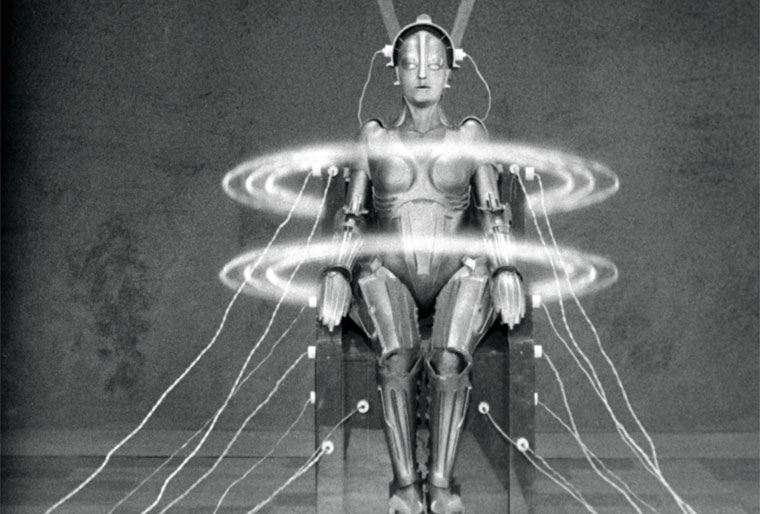Edison Studio Production
METROPOLIS (1927)
by Fritz Lang
restored version of 2010, duration 148 minutes
original soundtrack
created and performed live by
Mauro Cardi, Luigi Ceccarelli, Alessandro Cipriani, Vincenzo Core, Andrea Veneri
with the voices of Anna Clementi
and Martin Figura, Eric Moser, Marco Noia, Andreas Otto
a commission by Milano Musica and Ravenna Festival
with the collaboration of Tempo Reale – Firenze
Metropolis is a 1927 silent film directed by Fritz Lang, considered his masterpiece.
Lang sets the film in a dystopian future, in 2026, which is 100 years later than when it was written.
“Metropolis” is a big city, proud of its skyscrapers and its elevated streets, inhabited by very rich and largely idle people. But under its foundations, there is another city, that of the workers, where throngs of slavemen work on gigantic machinery and colossal power plants.
The film is one of the symbolic works of expressionist cinema and is universally recognized as a model of much of modern science fiction cinema, having inspired films such as Blade Runner and Star Wars.
screenplay Fritz Lang, Thea von Harbou
photography Karl Freund, Gunther Rittau
actors Alfred Abel, Gustav Frohlich, Brigitte Helm, Rudolf Klein-Rogge, Fritz Rasp, Olaf Storm, Theodor Loos, Erwin Biswanger, Heinrich George, Hans Leo Reich, Heinrich Gotho, Margarete Lanner, Max Dietze
restored by Friedrich-Wilhelm-Murnau-Stiftung, Wiesbaden
in collaboration with Deutsche Kinemathek – Museum for Cinema and Television, Berlin
and Museo del Cine Pablo C, Ducros Hicken, Buenos Aires
first performance
Milano, May 11 2023 | 8 pm
MEET Digital Culture Center – Theater
MILANO MUSICA 2023
Ravenna, June 16, 2023
Teatro Alighieri
RAVENNA FESTIVAL 2023
Roma, November 30, 2023
Parco della Musica, Teatro G. Borgna
60° Festival di Nuova Consonanza
Bisceglie (BT-Italy), December 21, 2023
Politeama Italia, Sonimage
Cluj Napoca (România), June 15, 2024
Banffy Castle, Bontida
TIFF – Transilvania Internațional Film Festival
Forlì (Italy), July 10 2024, Rocca di Ravaldino – Caterina Sforza
Area Sismica, comune di Forlì Estate 2024
Ferrara (Italy), 27 gennaio 2025
Teatro Comunale – Ferrara Musica
After having created the soundtracks of some great silent film masterpieces, Edison Studio is preparing to create the soundtrack of what is perhaps the most impressive and visionary of silent films: Fritz Lang’s Metropolis, in its most complete version ever found. , lasting two and a half hours. The futuristic and visionary character of the film lends itself perfectly to the creative work of Edison studio, based on the techniques of electroacoustic music, but very attentive to natural and instrumental sounds, used as a starting point for electronic processing ………
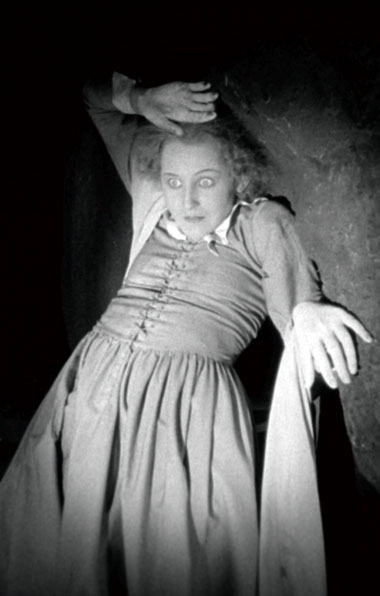
“The meeting between Fritz Lang’s film and Edison Studio is more than a film concert. The Italian group has had as profound an effect on film as 3D or IMAX camera technology has on contemporary cinema.
In addition to the musical twists stylistically matched to the specific art deco of the visuals, Edison Studio beautifully creates an entire sonic universe, effectively voicing the characters and filling the air with live sound effects. Sounds come from everywhere, broken into echoes, abstract synth moans, mechanical groans, so that Metropolis feels more 3D than Avatar, bigger than Dune, and more contemporary than I could have imagined. I left Bontida more of a cinephile than I arrived. What more could you want from such an event?”
Mircea Lasio (AperiTIFF, Festival magazine) 17/06/2024
Metropolis by Edison Studio at TIFF – Transilvania International Film Festival





The soundtrack by Edison Studio for Metropolis
After numerous successful previous experiences with some great silent film masterpieces, in 2023 the collective of composers-performers Edison Studio produced a new original soundtrack of what is perhaps the most visionary of silent films: Metropolis, by Fritz Lang.
The film is presented here in its most complete version ever found, the result of a refined restoration work by the Alpha-Omega Digital GmbH laboratory in Munich, completed in 2010. Unanimously considered Fritz Lang’s masterpiece, Metropolis is counted among the symbolic works of expressionist cinema, and is universally recognized as a model for much of modern science fiction cinema, having inspired films such as Blade Runner and The Matrix.
For Metropolis Edison Studio takes up the ancient tradition of silent film with live musical accompaniment, creating an original composition that mixes and makes hundreds of sounds interact with each other: sounds created ad hoc, but also drawn from sound sources borrowed from nature and the history of music, bringing to the scene acoustic instruments, objets trouvés, mechanical and electronic instruments, vocal sounds, all orchestrated, transformed and spatialized live. The futuristic and visionary character of Fritz Lang’s film lends itself perfectly to the creative work of Edison Studio, based on the research and experimentation of possible and “impossible” sonorities that arise from the creative interaction with the film, sometimes expanding its poetic intentions, sometimes reinterpreting the dramaturgical-narrative horizon and the vast range of possible symbolic implications.
The composition of the soundtrack for Metropolis – as for any previous work for the cinema composed collectively by Edison Studio – was preceded by a long process of analysis of the structure and the dramaturgy film. Although inextricably linked to the dramaturgy of the film, the music for Metropolis does not conform completely to the film to be merely at its service, nor to give a realistic sound representation to the silent images by providing them with a voice or a sound. Rather, while respecting the director’s and screenwriter’s intentions, their poetics, and the expressive tensions drawn in their work, the music for Metropolis aspires to be an expansion of Fritz Lang’s film. The rhythm of the images thus becomes “musical” in turn, reinventing its audiovisual time and highlighting otherwise hidden spaces and times.
The Metropolis soundtrack is therefore understood as a whole, in which even the extra-musical materials, those that could be reductively defined as “sound effects”, are an integral part of the music. And so are the verbal materials generated by the dialogues, which we have reconstructed, and for which we have referred to literary sources.
In fact, the emotion of the voice, normally absent in silent films, is often restored here, sometimes disregarding the strictly verbal content, other times starting from the naturalistic sound of the words and using it to give an identity that is not only emotional but also properly musical to the various characters and stage situations. A music therefore understood as a whole as an “organized sound”, referring to the thought of Edgar Varèse.
In the interaction between live music and silent film, in relationships of parallelism or opposition, significant processes are produced in the domain of audiovisual time and space, as well as in the general interpretation of the work. In particular, the work on the sound space, created by Edison Studio in surround 7.1, creates immersive dimensions that relate to the different levels of the Metropolis space. The sound, impossible to create in the 1920s, is imagined and reinvented, and in this way, it can be heard today, in the 2000s, the years in which, among other things, the story of Metropolis is set. A particular sound space was created for each setting in the film: the upper city of the rich, inspired by futuristic architectural models and built at the time with avant-garde techniques; Yoshiwara, the pleasure house in the Metropolis entertainment area; the city of workers, dark and located underground; the immense and visually extraordinary factory, with the “machine M” which rhythmically marks the inhuman work of the workers and the clocks which relentlessly count down the ten working hours; the catacombs, located on a third level below the city of the workers, where they meet clandestinely; the eternal gardens, where the children of the rich enjoy themselves unaware of the existence of the lower levels.
The design of the sound environment and the music that interacts with the characters, the dialogues, and the actions within which the scenes develop, generate an overlapping of different sound layers. The formal organization therefore represents a synthesis of the counterpoint and the dialectic that is established between the superimposed audiovisual layers, within the general architecture designed by the narrative structure of this masterpiece.
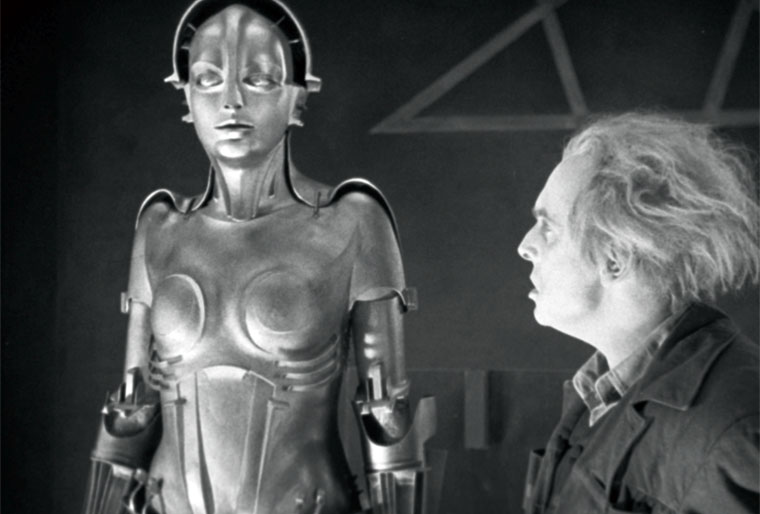
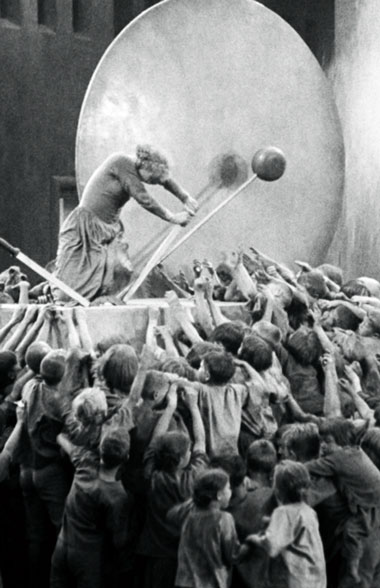

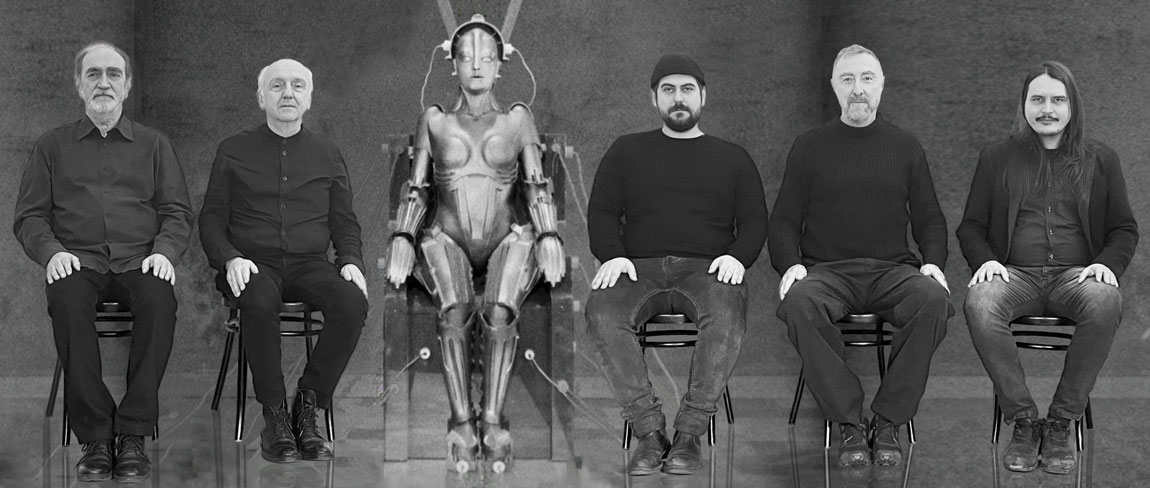
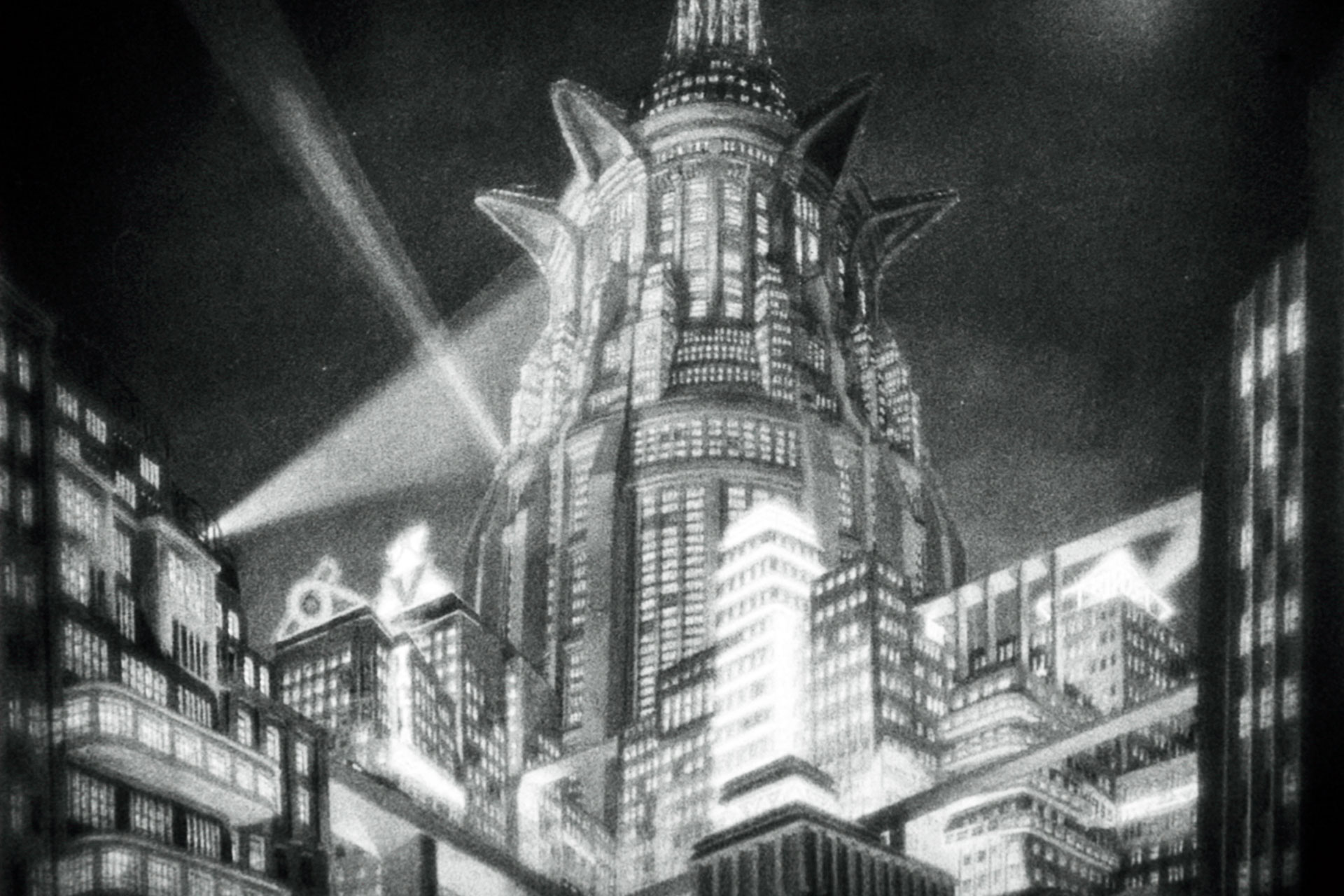
REVIEWS
“The New Noise”, 11/30/2023
Toni De Martino
The Roman collective Edison Studio, founded in 1993, is one of the most established production centers in the field of international electroacoustic music and is certainly not new to experimenting with masterpieces of cinema from the past: titles such as “Das Cabinet des Dr. Caligari”, “Battleship Potemkin” or even “Inferno” demonstrate how you seek a contemporary and new musical reading of films that have long entered the collective imagination.
“Metropolis” (1927) by Fritz Lang, based on the novel by Thea von Harbou, one of the most visionary and prescient silent films, and a true manifesto of expressionist cinema, was presented within the Festival Nuova Consonanza in its most complete version ever found, the result of a complex restoration work by the Alpha-Omega Digital laboratory in Munich.
On stage Mauro Cardi, Luigi Ceccarelli, Alessandro Cipriani, Vincenzo Core and Andrea Veneri. In addition to the laptops, a dulcimer, the mini Akai MPK, a couple of violins, percussion and cymbals, and a Fender Telecaster stood out. They positioned themselves in the background, all in black, almost invisible to the public’s gaze while the images scrolled solemnly and frenetically on the big screen behind them. They then interacted with the film with instrumental, mechanical, digital, vocal sounds, and field recordings, all orchestrated and manipulated live. In this case, the direction of the sound was the responsibility of Luigi Ceccarelli, with the music transmitted from ten speakers positioned high above the audience for a spatialization synchronized with the restored and sparkling frames that millions flowed into the eyes of an audience enveloped in a totally immersive experience. We left dazed and happy as after a high psychedelic trip, a vision of Metropolis substantially reinvented even if still faithful to the hyper-expressionist line: certainly the most astonishing moments coincided with those in which the evil clone of the heroine Maria led the masses to the catastrophic Luddite solution!
The five from Edison Studio say: “The futuristic character of Lang’s film lends itself perfectly to our work. Everything was born after a long film analysis and from a multi-voiced reflection in which different previous experiences are put at the service of a common project. Our music for Metropolis aspires to be a sort of expansion of the film, the rhythm of the images thus becomes musical reinventing its audiovisual time and highlighting hidden spaces and times.”
Until the next soundtrack, therefore, with a suggestion: Tod Browning’s masterpiece “Freaks”, anno Domini 1932
“The Hollywood Reporter” May 12, 2023
Caterina Orsenigo
Sounds, voices, noises, machines, and algorithms: the collective of composers Edison Studio created a new live soundtrack at the MEET in Milan for the full version of Fritz Lang’s iconic film. Alessandro Cipriani to THR Rome: “We integrated music and ambient sounds, but we also managed to reconstruct the original dialogues”.
It feels like being in the theater. Immersed in a thick cloud of sounds, voices, the pounding pace of the machines, roaring factory din, fatigue, madness. And silences. Exasperated gestures. Characters who speak with words, others who dialogue with ticks, jingles, and clicks.
We are at the Meet – Digital Culture Center in Milan, former Spazio Oberdan, in the room that for decades has hosted the best film retrospectives in the city. On the screen one of the most iconic silent films in the history of cinema and then an unusual orchestra accompanies. This is the collective of composers-performers Edison Studio, composed of the founding members Alessandro Cipriani, Mauro Cardi, and Luigi Ceccarelli, to which Vincenzo Core and Andrea Veneri are being added: a historic collective, born in 1993, among the most important in the world of electroacoustic music production. Often working with the Cineteca di Bologna, in the past they created the soundtracks of other masterpieces of silent cinema: The Cabinet of Doctor Caligari by Robert Wiene (1919), Blackmail by Alfred Hitchcock (1929), Inferno by Francesco Bertolini and Adolfo Padovan ( 1911), Battleship Potemkin by Sergej Michajlovič Ėjzenštejn and now the time has come for Metropolis.
Metropolis, return to 2026
Released in 1927, almost a century ago, Metropolis is set in 2026: very soon. A symbolic work of expressionist cinema, directed by Fritz Lang, it imagined a future in which class differences are exacerbated to the maximum, industrialists govern from the top of skyscrapers while proletarians are relegated to working in the incandescent and rhythmic darkness of the city underground, almost like in a Bon Joon-ho movie today.
But the imagery is completely different: dizzying architecture, masses of workers in very orderly rows, crowds that come to life and rebel in sync, and then the machinery, the rhythmic and resounding movement of the gears, the circular motion of the cogwheels. And the story of Freder, son of the entrepreneur-dictator of the city of Metropolis, who has always lived in a protected Eden and who, in love with the teacher and prophet Mary, begins a journey into the underworld of the city, among the workers crushed by schedules and inhumane working conditions. And then of a mad scientist in love who builds android robots in the hope of being able to bring a beloved woman back to life.
A year of work
…….. the work of Edison Studio transforms Metropolis into something much more alive, much closer to the theatre: an enveloping experience made of music, pounding noises, rushing water, and then voices. The characters now speak.
Alessandro Cipriani, one of the founding members of Edison Studio, says: “For us the emotion of the voice is important and from time to time, depending on the film, we work on this aspect in different ways. Sometimes with vocal, guttural sounds, but without words, other times with instruments that imitate the emotion the character is feeling in that moment. With Metropolis, however, we did a different job, much more demanding. There is a part of the film that is very dense with dialogue, plot, and emotions. Here we have reconstructed the entire conversation. It was a work of about a year, we went to study the original novel written by Thea von Harbou, who was Fritz Lang’s wife, and then the screenplay of the film written by Harbou and Lang. And so with the help of collaborators German speakers, we managed to reconstruct the lips and therefore recreate all the dialogues. Several German actors worked with us and we dubbed the characters.”
Voices and sound environments
To this we obviously add the work on the soundtrack, which Cipriani explains to us like this: “We don’t mean the soundtrack just as music but in a global sense, we also work on voices and sound environments. Or put another way, even ambient noises or voices are music for us. An integration must be created between voices, machine sounds, ambient noises, and music so that they become one. Metropolis has been featured in countless science fiction films and we wanted to bring this level of technology and dimension of the future to sound too.”
Technology also plays a very important role in the last piece of Edison Studio’s sound work: reception in the room. The Milan Meet room is equipped with 7.1 surround sound, an immersive sound that “spatializes” the sound effects so that the sound “moves” around people.
From electric guitars to Turkish sounds
Edison Studio is therefore present live in the room, like a real orchestra: there is a sound director who works on mixing and spatialization, and then four people are on stage with various electronic and non-electronic instruments. An electric guitar, some percussion, and a khim (traditional dulcimer from Thailand). But the sound of these instruments does not reach our ears directly: they pass from microphones and microphones to the computer so that, through a series of algorithms prepared by the composers themselves, they modify and adapt in the timeline with what happens in the movie. Finally, there are the parts already recorded that are therefore not “played” live: in particular the voices and in general those that must be in sync with the frame.

